The Complete Indoor LED Spotlight Guide for Home
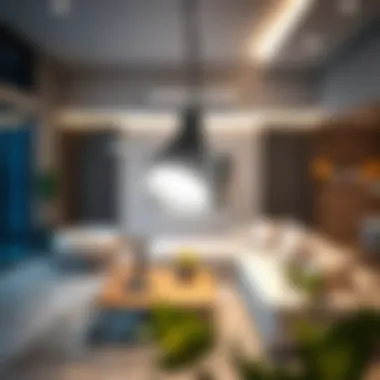
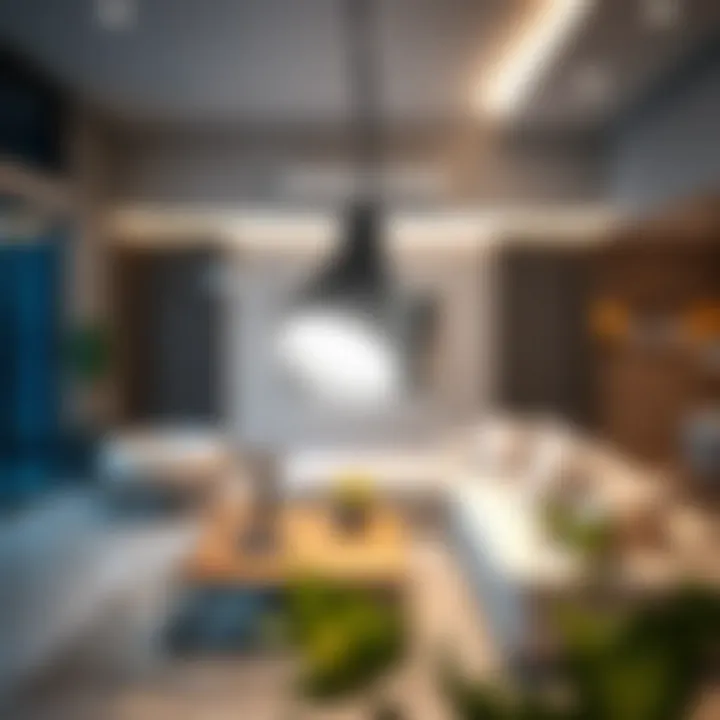
Intro
Indoor LED spotlights have emerged as an essential element in modern interior design, as they not only illuminate spaces but also enhance the overall ambiance. Their versatility lies in the ability to create various lighting effects, with options that suit specific needs and preferences. In today’s fast-paced world, where energy efficiency and sustainable living are more important than ever, homeowners and designers are turning to these sustainable lighting solutions. Understanding this kind of lighting fixture can significantly impact the aesthetic and functionality of an indoor environment. This guide aims to provide an in-depth look at the features, benefits, and best practices for utilizing LED spotlights in residential settings, whether for a cozy living room, an elegant dining space, or a functional workspace.
Furniture Design Trends
Trending Materials and Textures
When selecting furniture for spaces illuminated by LED spotlights, the choice of materials and textures plays a considerable role. Wood, metal, glass, and fabric all offer unique interactions with light, allowing for different effects in a room.
- Wood: Often brings warmth and character. Depending on the type of wood, the grains can catch light beautifully, resulting in visually appealing contrast against LED spotlights.
- Metal: Provides a sleek, modern vibe. Polished metals can reflect light, enhancing the brightness of the area, while brushed finishes can tone down the glare for a softer glow.
- Glass: Adds elegance. Glass surfaces can diffuse light, creating a gentle ambiance that works well in living areas or dining settings.
- Fabric: Soft furnishings can absorb or diffuse light, leading to different feels. Textiles in striking colors or intricate patterns become focal points under strategically placed spotlights.
Color Palettes and Styles
The color palette chosen for a space can dramatically influence how LED spotlights perform.
- Light colors: Illuminate rooms, making spaces feel larger and airy. Consider whites, pastels, and light grays for a fresh look.
- Dark colors: Create a dramatic effect and add depth, especially when spotlighting specific features, like artwork or architectural details.
- Contrasting colors: Use spotlights to emphasize texture and depth, making furniture pieces pop against their backgrounds.
Architectural styles also dictate how spotlights should be used. For instance, modern minimalist designs benefit from clean lines and straightforward placement, while traditional styles may require more intricate arrangements to enhance classic aesthetics.
Practical Tips for Furniture Selection
Assessing Space and Functionality
Before making any purchase, evaluate the space in which you plan to use LED spotlights. Consider the dimensions and layout, as well as the purpose of the room. Would the spotlighting be for general lighting, or focused on certain items, like artwork or a family portrait? Determining these factors will guide your decisions.
Balancing Aesthetics with Comfort
Ultimately, the goal is to create a space that is not only visually appealing but also comfortable and functional. Combining soft sofas with bold armchairs can create an inviting environment. Furthermore, ensure that lighting fixtures reflect the intended use of the room—for instance, a well-lit workspace might benefit from brighter, cooler tones, while a cozy reading nook might need softer, warmer light.
"The right lighting can transform a house into a home. It’s about creating atmosphere and functionality simultaneously."
In summary, choosing the perfect blend of lighting solutions and furniture requires an understanding of the interplay between light and design. This balanced approach not only enhances the beauty of interiors but also improves the quality of life within those spaces.
Further Resources
For additional information, consider exploring the following resources:
- Wikipedia on LED Lighting
- Britannica on Interior Design
- Check out discussions on Reddit for community tips and experiences related to LED spotlights and interior design.
Prelims to Indoor LED Spotlights
In today’s world, lighting goes far beyond just illuminating spaces. It taps into the very essence of how a room feels, functions, and flows. With this in mind, indoor LED spotlights have emerged as a popular choice among homeowners, designers, and decorators alike. Their importance in modern interior design cannot be overstated. They not only brighten up corners but also contribute significantly to the aesthetic appeal of a space.
When thinking about indoor LED spotlights, several elements come to the forefront. First, consider the energy efficiency these fixtures bring. LEDs consume significantly less power compared to traditional incandescent bulbs, resulting in lower electricity bills and a smaller carbon footprint. This feature speaks volumes in an age where sustainability is a pressing concern. Couples this with their long lifespan, and one begins to see how these lights are both economically and environmentally savvy.
Moreover, versatility is another crucial aspect of indoor LED spotlights. They can be used in numerous settings, whether highlighting an artwork or providing focused light for specific tasks. The ability to adjust intensity and color temperature also allows users to customize ambiance according to their preference. Not only do they serve practical functions, but they also help mold the character of a space.
However, it’s essential to approach the choice with thoughtful consideration. Factors like placement, style, and technical specifications should not be taken lightly. A poor selection can lead to harsh lighting that diminishes a room’s beauty or even creates uncomfortable glare. As a result, understanding how to properly integrate LED spotlights into existing interior designs is crucial for achieving the desired look and feel.
"Lighting often silences and amplifies spaces, guiding how they are perceived and experienced."
Prepare to explore the nuances of LED technology, advantages of spotlights, and practical installation strategies that align with your interior vision.
Understanding LED Technology
Understanding LED technology is crucial for grasping the essence of indoor LED spotlights. As homeowners, designers, or decorators, recognizing how LEDs function can greatly enhance your ability to select the right lighting solutions for different spaces. LED, which stands for Light Emitting Diode, represents a significant leap in lighting technology, offering benefits that extend far beyond those of traditional incandescent or fluorescent bulbs.
What is LED?
In simple terms, LED refers to a semiconductor device that emits light when electricity passes through it. The technology itself is not new; it has been around for decades, initially used in indicators and small displays. However, the evolution of LED technology into a feasible option for general illumination has been revolutionary. Unlike conventional bulbs, LEDs do not rely on heat to produce light. This results in significantly lower energy consumption and reduced heat emission, making them an ideal choice for any indoor setting.
Key Features of LEDs:
- Energy Efficiency: LEDs use up to 90% less energy than incandescent bulbs, contributing not just to cost savings, but also to reducing the carbon footprint.
- Longevity: An average LED can last upwards of 25,000 hours. This means fewer replacements and less waste over time.
- Durability: LEDs are solid-state lights, meaning they are more resistant to damage compared to fragile bulbs.
- Color Variety: LEDs are available in a wide range of colors and can be adjusted for different moods and atmospheres.
How LED Works
To understand how LED spotlights work, it's essential to first delve into the components that make up an LED light. At the core, an LED consists of a chip made from semiconductor material, usually gallium arsenide or gallium nitride. When an electrical current passes through this semiconductor, electrons recombine with holes in the material, releasing energy in the form of photons—this is the light we see.
Moreover, LED technology has advanced considerably. It's not just about turning on and off; many modern LEDs offer tunable white light, allowing the user to adjust both color temperature and intensity. This adaptability makes LEDs suitable for a myriad of indoor applications.
"Understanding the functionality of LED technology not only empowers decision-making but also enhances the aesthetic value of interior spaces."
By comprehending the core principles of how LEDs operate, you can better evaluate the features you need in indoor LED spotlights, ensuring your lighting choices align perfectly with your design goals.
Advantages of LED Spotlights
In recent years, LED spotlights have surged in popularity within the realm of interior design, and it's not just for aesthetic reasons. Understanding the advantages of LED spotlights forms a crucial part of making informed decisions about indoor lighting. These benefits stretch beyond mere brightness; they encompass energy efficiency, durability, and even health aspects associated with heat emission. Let’s dive into each of these advantages in detail.
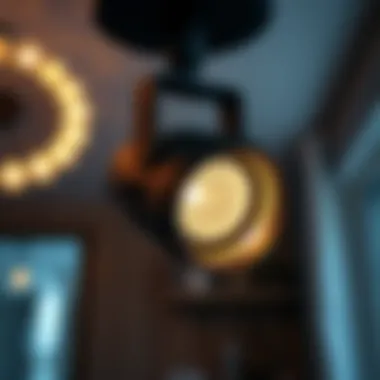
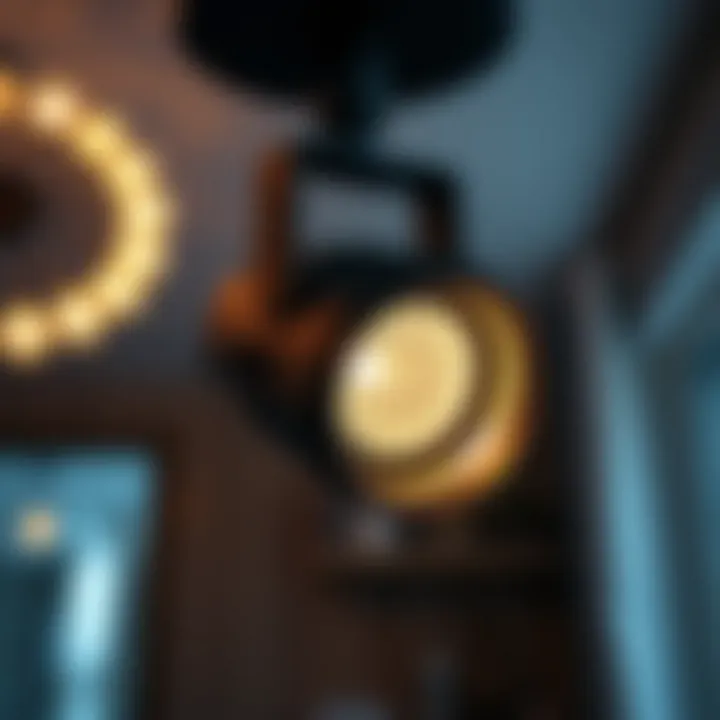
Energy Efficiency
When it comes to lighting, energy efficiency is like finding a needle in a haystack. LED spotlights shine bright in this department, using up to 80% less energy compared to traditional incandescent bulbs. This significant reduction means not only a smaller carbon footprint but also noticeable savings on monthly electric bills.Infact, if you were to replace a standard 60-watt incandescent bulb with an LED spotlight, you would only need around 10 watts to achieve the same brightness, a real steal for homeowners.
"The longer the lifespan, the fewer replacements, and the more you save!"
It's essential to recognize that energy-efficient lighting options also lead to an overall reduction in energy demand. This not only lessens the load on electrical grids but also extends the life of your bulbs, as they don’t have to work as hard. Even as technology advances, opting for LED lighting remains a sensible choice in any energy-conscious household focused on long-term sustainability.
Longevity and Durability
One of the standout characteristics of LED spotlights is their impressive lifespan, averaging between 15,000 to 50,000 hours. This contrasts sharply with incandescent bulbs, which commonly last only about 1,000 hours. Imagine installing your LED spotlights and not having to think about replacements for years.
In addition to longevity, LED spotlights are also more robust than their traditional counterparts. They are built with solid-state components, which makes them less susceptible to damage from shocks, vibrations, or other environmental factors. It’s as if they are fighting fit—ready to withstand the wear and tear of daily life. Therefore, for areas such as kitchens or workshops with high activity, these lights can outlast everything else, providing a wise investment choice.
Low Heat Emission
Another crucial advantage worth noting is the low heat emission of LED spotlights. Traditional bulbs tend to waste a lot of energy in the form of heat, which can lead to overheated rooms, fire hazards, and discomfort; think about entering a stuffy kitchen after a long cooking session. In stark contrast, LEDs generate significantly less heat, making them safer and more comfortable to use, especially in enclosed spaces and during long periods of lighting.
Additionally, this reduced heat output contributes to a more stable indoor climate. It keeps your space cooler while reducing the load on air conditioning systems, ultimately leading to further energy savings. Lower temperatures also mean that surrounding decor and furniture are less likely to undergo damage or fading over time from excessive heat exposure.
Common Uses of LED Spotlights Indoors
Understanding the diverse applications of LED spotlights is essential for any homeowner, designer, or decorator looking to enhance indoor spaces. The versatility of these lights makes them a prime choice for various functionalities, providing both aesthetic appeal and practical benefits. Whether it’s highlighting a key feature of your home or ensuring that tasks are performed in adequate lighting, knowing how to utilize LED spotlights can greatly improve the atmosphere and functionality of a room.
Accent Lighting
Accent lighting serves as a powerful tool to manipulate a room’s aesthetics. By focusing light on specific objects, this type of lighting can create a strong visual impact. For instance, illuminating a piece of art or a sculpture with LED spotlights can make it the focal point of a room, drawing the eyes of anyone who walks in. This approach not only emphasizes the beauty or importance of the featured item but also sets the mood for the overall environment.
When deploying accent lighting, the key is to aim for a balance. Too much light can overwhelm the space, while too little may go unnoticed. Typically, accent lights should provide at least three times the amount of light on the object than the surrounding light levels. A warm light can exude a cozy vibe, while a cooler tone may add a more modern twist.
"Accent lighting isn't just about function; it’s about storytelling and creating ambience in your living or working spaces."
Task Lighting
Task lighting is essentially focused light that helps with specific activities in a space. Think about your office desk, kitchen countertop, or workspace where precise tasks are performed. LED spotlights here can make all the difference by eliminating shadows and providing a clear view, thus reducing eye strain and increasing productivity. For example, a well-placed LED spotlight above a kitchen island allows for seamless meal preparation and enhances the cooking experience.
When selecting task lighting, consider the height and angle of installation. Lights that are too high or poorly angled can create glare instead of illumination. Dimmer switches can be extremely useful in task lighting setups, allowing flexibility in brightness depending on the need at hand. It’s also important to think about the color temperature; brighter, cooler whites (around 4000K to 5000K) are better for work areas as they help people stay alert and focused.
Ambient Lighting
While accent and task lighting serve specific purposes, ambient lighting sets the overall tone of a space. This is the general light that fills a room, creating a comfortable atmosphere. LED spotlights can play a significant role in developing this serene environment. By layering ambient lighting with dimmable LED spotlights, the room can transform from a bright workspace during the day to a softer, more relaxed setting in the evening.
Using LED spotlights for ambient light often involves strategic placement, such as highlighting ceilings or certain architectural features. This technique casts a gentle glow that enhances the ambiance without overwhelming the senses. It’s always beneficial to position spotlights to blend seamlessly with other light sources, ensuring a well-distributed illumination throughout the space.
Choosing the Right LED Spotlight
Selecting the right LED spotlight can be as important as picking out the furniture for your living space. It’s not just about illumination; it involves crafting an atmosphere that reflects your style while addressing functionality. An effectively chosen spotlight can serve as a accent, task light, or even commodious ambient light, elevating the overall experience of any room.
Lumens and Brightness Levels
Lumens measure the brightness of a bulb, and understanding this metric is crucial when it comes to choosing LED spotlights. Unlike the outdated wattage measurement, lumens focus squarely on the amount of light produce. For instance, if you're lighting a cozy reading nook, you might opt for a light source providing around 800 lumens, perfect for that peaceful vibe without feeling as bright as a sun beam.
In general:
- 300-500 lumens: Ideal for ambient lighting in soft areas like bedrooms.
- 800-1600 lumens: Great for task areas like kitchens and reading spots.
Choosing lumens matching your need prevents an overly bright room that could be as stinging on the eyes as a flock of seagulls squawking at sunrise.
Color Temperature Selection
When it comes to selecting color temperature, think about the mood you wish to create. Color temperature is measured in Kelvin (K), with lower numbers indicating warmer tones.
- 2700K-3000K: Produces a warm yellow glow, akin to traditional incandescent bulbs, often used in cozy, intimate settings.
- 4000K: A reasonable middle-ground that offers a neutral white light appropriate for workspaces or kitchens.
- 5000K and above: Delivers a cooler, bluish hue, best reserved for areas requiring high clarity, like offices or art studios.
Remember, the choice isn’t merely about aesthetics but also about utility; the wrong hue can easily dampen the atmosphere and affect productivity.
Beam Angles and Distances
Beam angle relates to the width of light emitted from the spotlight. Understanding this aspect can truly make or break your room's lighting design.
- Narrow beam (10-30 degrees): Best for accent lighting, spotlighting specific objects like artwork or architectural details.
- Medium beam (30-60 degrees): Works well for task lighting, providing adequate coverage for an entire table without washing out the glow.
- Wide beam (60 degrees or more): Excellent for ambient lighting, casting a broad wash of light across larger areas.
Distance from surfaces also needs consideration. Spotlights placed too close might create harsh shadows, while those too far can appear feeble. Finding the sweet spot is all about trial and error, coupled with a good measure of intuition and patience.
"Choosing the right spotlight is like piecing together a puzzle; every choice leads to a final image of your perfect space."
Design Considerations for LED Spotlights
When it comes to indoor lighting, design is not just a matter of aesthetics but also of functionality and harmony with the space. LED spotlights, in particular, provide a unique opportunity to blend these aspects seamlessly. Selecting the right LED spotlights requires careful thought regarding their integration with existing décor and the variety of fixture styles available.
Integration with Existing écor
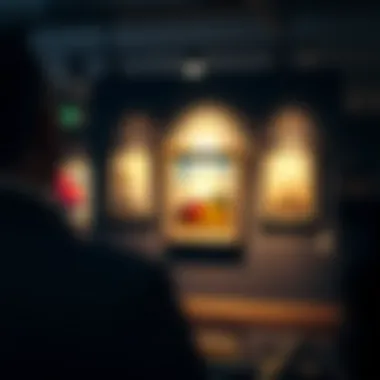

The way LED spotlights fit into your home’s overall aesthetic can significantly alter the mood and function of a room. Homeowners often overlook this aspect, thinking purely of brightness or energy savings. However, the integration of lighting fixtures like LED spotlights into established design elements is crucial. Choosing the right spotlight involves assessing the colors, materials, and decor themes already in place. For instance, if your living room embraces a minimalist theme dominated by neutral tones, sleek and unobtrusive spotlights would enhance this without overwhelming the space. In contrast, a rustic-themed room might benefit from fixtures with warmer finishes, evoking a cozy atmosphere.
Additionally, it’s essential to consider how light interacts with surfaces and materials in your space. Glossy finishes can reflect light in unexpected ways, while matte textures absorb more light. Noting these details can help in choosing spotlights that evoke the desired ambiance. Thus, the integration process shouldn't merely be about fitting them into the room but about creating a cohesive storytelling of design.
Fixture Styles and Finishes
When choosing LED spotlights, the variety of styles and finishes can be dazzling. From contemporary to vintage, the style of your spotlight can either complement or clash with existing decor. Spotlights come in myriad designs ranging from industrial metal finishes to elegant, polished chrome options. For a modern setting, fixtures with clean lines and geometric shapes can enhance the sleekness one might desire.
On the other hand, if your home leans more towards traditional or eclectic styles, you might want to consider fixtures with intricate details or vintage-inspired finishes. Choosing the right finish is equally important; a matte black spotlight might work brilliantly in a trendy urban apartment, while an antique brass finish could elevate the charm in a heritage home.
Choosing the right fixture couples visual appeal with practicality. Consider an adjustable spotlight that can pivot to highlight specific areas, perfect for artwork or architectural features. This adaptability not only maximizes effectiveness but also adds a dynamic quality to your lighting scheme.
"Choosing LED fixtures to blend with your décor enriches not just the light but the soul of your environment."
For further insights and ideas on integrating lighting into your space, consider visiting Britannica or Wikipedia for a comprehensive understanding of designs that fit your unique needs.
Installation Guidelines
Installing LED spotlights requires thoughtful planning and precision. The right installation can amplify the benefits of these lights, enhancing not only the lighting but also the ambience of your home. This section outlines key considerations and best practices for getting your LED spotlights set up properly.
Professional vs. DIY Installation
When it comes to installing LED spotlights, homeowners find themselves at a crossroads between hiring a professional or embarking on a do-it-yourself adventure. Both options carry their own merits and pitfalls.
Hiring a professional can ensure that the installation meets local electrical codes and maintains safety standards. Experts are familiar with various lighting layouts, which helps in achieving optimal results while avoiding common mishaps. Plus, they have the right tools, which makes the job easier and quicker. However, this route does come with costs that could strain your wallet.
Conversely, the DIY path can be appealing for those with a knack for home improvement. It allows you to tailor the installation to your specific needs and save money in the process. It’s crucial, however, to have a solid understanding of electrical work and safety guidelines. Reckless handling of electrical systems can lead to hazards that are best avoided. Therefore, if you chose to go the DIY route, allocate ample research time. Familiarize yourself with your electrical setup, and don’t hesitate to reach for professional help if needed.
Electrical Safety Tips
Electricity is no joke, and safety should always be the top priority during installation. Here are several vital tips to keep in mind
- Power Down: Before commencing, always turn off the power at the circuit breaker to prevent any electrical shock when handling wiring.
- Use Quality Tools: Ensure your tools are in good condition. Worn-out tools can lead to accidents or damage.
- Choose the Right Fixtures: Verify that the spotlights are compatible with your electrical system. Misalignment can lead to flickering lights or worse.
- Proper Location: Avoid placing LED fixtures too close to flammable materials like wood or fabric. Also, be mindful of where the fixtures will cast light to avoid glare or shadow.
- Check for Damage: Inspect the wiring for any signs of wear or damage prior to installation. Frayed wires can become fire hazards.
Always consult a qualified electrician if you're unsure about any aspect of the installation process.
By adhering to these guidelines, you not only enhance the functionality of your indoor lighting but also ensure a safe and efficient installation process.
Placement Strategies for Optimal Lighting
Placement strategies for indoor LED spotlights are crucial for creating an atmosphere tailored to your space's needs. The way you position your lights can transform a room from drab to fab, enhancing its functionality while elevating the overall aesthetic. Poor placement might lead to shadows or glaring headlights, while the right positioning can yield a harmonious blend of light, warmth, and practicality.
Height and Distance from Walls
One of the fundamental aspects of lighting design lies in the height at which spotlights are installed and their distance from walls. Generally, spotlights should be placed higher than your head level, at least 7 to 9 feet from the floor in most cases. This height minimizes harsh shadows on faces and surfaces and ensures a even distribution of light.
When it comes to distance from walls, a common guideline is to maintain between 1.5 to 2 times the height of the spotlight from the wall. If the light is too close, you’ll risk creating a hot spot, and if it’s too far away, the effect will be lost, resulting in a vague wash of light without focus. Therefore, careful calculation is necessary to maximize the beam spread and cover the desired area effectively.
For instance, if your spotlight is mounted at 10 feet, it would ideally be 15 to 20 feet away from the wall for best effect. This can work wonders in living rooms, where over-illuminated spots can create an uninviting environment, rather than the cozy nook most people desire.
Layering Light Sources
Layering is a concept borrowed from design realms, particularly when it comes to textiles or colors. In lighting, layering translates to using multiple types of light sources to create depth and interest in a room. Simply throwing in a few spotlights won't cut it; a multifaceted approach is what makes your lighting scheme truly sparkle.
There are generally three types of light to consider: ambient, task, and accent lighting. Ambient lights provide overall illumination, like ceiling fixtures, while task lights focus on specific activities, such as reading or cooking. Accent lighting highlights features of your space, creating focal points—this could be art, or architectural details.
Using LED spotlights in combination with these other light types can enhance the visual effects rhythmically across your home. For example, you might place LED spotlights to accentuate a piece of artwork while soft ambient lighting bathes the room in warmth. This way, not only do you achieve functional lighting, but you also create moods and experiences for your guests.
Remember, in lighting design, less can often feel like more, provided each layer does its job harmoniously without casting competing shadows on one another.
"A well-lit room is more than just the absence of darkness; it's about creating the right atmosphere with every beam of light."
By implementing thoughtful strategies around height, distance, and layers, you will not just brighten up the room but infuse it with character and warmth, making your indoor environment as inviting as a breath of fresh air.
Maintaining LED Spotlights
Keeping indoor LED spotlights in good condition is a task that pays dividends in both aesthetics and functionality. Just like any other part of your home, these fixtures require a bit of care to keep performing at their best. Poorly maintained lighting can lead to dim illumination, unsightly buildup, or even unexpected failures. Luckily, maintenance isn’t rocket science—understanding a few key practices can vastly extend the lifespan and efficiency of these energy-saving devices. In this section, we will dive into essential cleaning techniques and common troubleshooting tactics to ensure your LED spotlights shine brightly and effectively.
Cleaning Techniques
Regular cleaning is paramount when it comes to maintaining LED spotlights. Dust and grime can envelop lenses and circuit boards, causing light output to diminish over time. Here are some effective techniques for cleaning your LED fixtures:
- Power Down: Before any cleaning task, always turn off the lights to avoid electrical mishaps.
- Use a Soft Cloth: Grab a microfiber cloth that's dry or slightly damp. This choice helps to avoid scratches—conventional rags may be too abrasive.
- Gentle Wiping: Wipe down the exterior surfaces and the lenses with soft, circular motions. Be particularly cautious with the lenses, as any scratches or smudges can scatter light and create a less-than-ideal ambiance.
- Avoid Harsh Chemicals: Stick to mild soap solutions if necessary. Chemical cleaners can be corrosive and may damage the fixture's finish or internal components.
- Frequency of Cleaning: Dust tends to settle over time, so a good practice is to give your fixtures a thorough clean every month or two, depending on dust levels in your home.
These simple cleaning steps can greatly improve the clarity and brightness of your spotlights, yielding a more inviting atmosphere in your living spaces.
Troubleshooting Common Issues
Despite all precautions, you might run into some common problems with your LED spotlights. Understanding how to troubleshoot these issues is essential in maintaining their performance. Here are some issues you might encounter and how to address them:
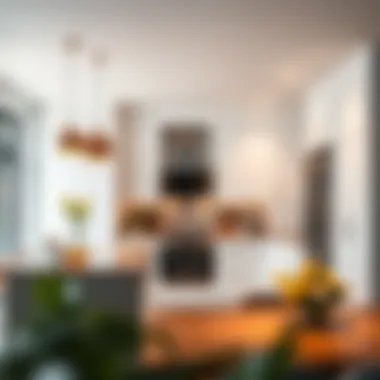
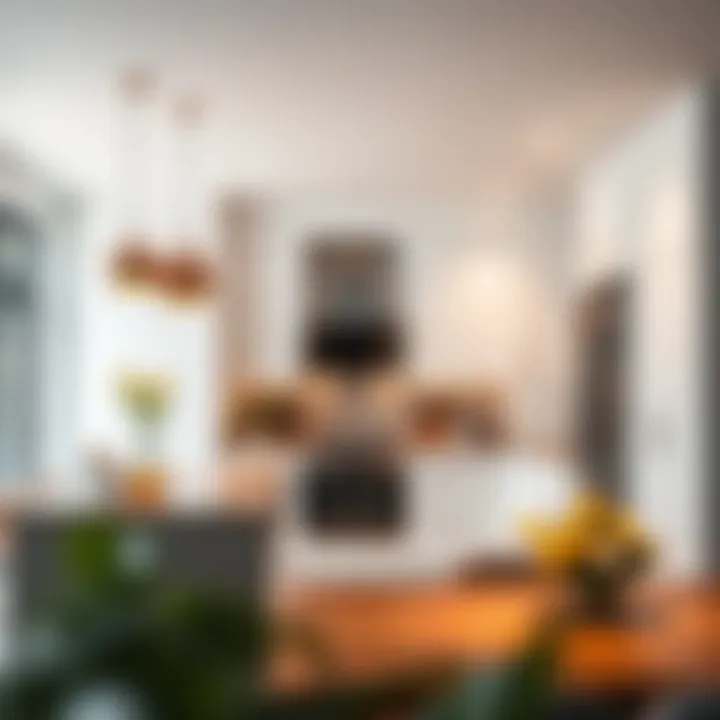
- Flickering Lights: If your LED spotlights flicker, it may indicate an unstable connection or an incompatible dimmer switch. Inspect the connections and consider switching to an LED-compatible dimmer.
- Dimming Without a Dimmer: A drop in brightness could mean accumulated dust yet again, or possibly aging LEDs. First, clean the fixtures as previously discussed. If the issue persists, replacement of the bulb might be necessary.
- Uneven Lighting: If certain areas look dimmer, adjusting the placement of the fixtures might solve the problem. Experiment with angles to ensure even lighting coverage across your space.
- Sudden Failure: If an LED spotlight completely stops working, check the circuit and connections first. An unexpected failure might often stem from electrical issues, which can sometimes be easily rectified. Consider consulting with a professional electrician for in-depth problems.
By keeping these maintenance practices and troubleshooting tips in mind, you can ensure that your indoor LED spotlights remain in top shape, lending both function and beauty to your space. This diligence not only enhances your environment but also extends the lifespan of your lighting, making every flick of the switch a moment of illuminating joy.
The Environmental Impact of LED Lighting
The environmental aspect of lighting is often overlooked, yet its significance cannot be understated. As lighting solutions evolve, the focus on sustainability and eco-friendliness becomes central. LED lights are not just a fleeting trend; they represent a significant shift in how we illuminate our spaces while being mindful of the planet. Here, we'll delve into the myriad ways LED lighting contributes positively to the environment, while also discussing certain considerations that come with this technology.
One of the primary advantages of LED lighting is its energy efficiency. LEDs consume far less energy compared to traditional incandescent and fluorescent bulbs. For instance, an LED spotlight can use up to 75% less energy than an incandescent bulb. This reduction in energy consumption leads to lower greenhouse gas emissions from power plants, contributing to a decrease in air pollution. When one considers that lighting can account for nearly 20% of a household's electricity usage, the potential impact of switching to LED lighting becomes apparent.
Furthermore, LEDs have a longer lifespan than their traditional counterparts. On average, an LED can last up to 25,000 hours or more, compared to the 1,000 hours of a regular bulb. This longevity not only means fewer replacements but also less waste in landfills. Fewer discarded bulbs translate to fewer resources spent on manufacturing and transportation, which further reduces carbon footprints.
"Switching to LED lighting is not just a step towards savings; it's a leap towards sustainability."
Toxicity and Recycling
However, it's crucial to address the considerations tied to LED technology. While LEDs are generally more environmentally friendly, they are not devoid of concerns. Most LED bulbs contain small amounts of harmful substances like lead and arsenic. Disposing of these bulbs requires certain measures to avoid environmental contamination. Some manufacturers are stepping up by providing recycling programs, encouraging users to send back used LEDs for proper disposal. Therefore, while embracing LED technology, one should also remain aware of proper end-of-life disposal practices.
Life Cycle Assessment
A comprehensive evaluation of LED's environmental impact should include a life cycle assessment. This analysis encompasses everything from raw material extraction to manufacturing, transportation, usage, and ultimate disposal. The results often showcase that despite their initial manufacturing footprint, LEDs emerge as a more sustainable option when considering their efficiency and longevity over time.
Community Awareness
Raising awareness about the environmental benefits of LED lighting can spur on more homeowners, designers, and decorators to make informed choices. Communities can engage in workshops highlighting the benefits of LEDs, not just in terms of energy savings but also in aligning with greener living practices. This shift in mindset can help illuminate a path toward a more environmentally conscious approach to lighting.
Future Trends in Indoor Lighting
As the ceiling of technology keeps rising, indoor lighting is not lagging behind. Understanding future trends in indoor lighting, particularly regarding LED spotlights, is essential for homeowners and designers. With innovations rapidly developed, being aware of advancements helps individuals choose fixtures that enhance functionality while remaining stylish and energy-efficient.
One significant trend is the integration of smart lighting technology. This development has drastically changed how we interact with indoor lighting. Homeowners are increasingly opting for systems that allow them to control lighting via smartphones or voice commands. The convenience of adjusting brightness or color temperature through an app can enhance everyday life in ways that previously seemed like science fiction.
Smart Lighting Technology
Smart lighting technology incorporates connected devices that transform ordinary fixtures into part of a sophisticated home ecosystem. Here’s why this matters:
- Automation: Users can set schedules or automate their lights to turn on and off at specific times. This not only adds comfort but also provides added security by making it seem like someone is at home even when they’re not.
- Customization: Features like dimming options and color-changing bulbs allow for personalized ambiance in various spaces, making it easier for designers to create unique atmospheres.
- Energy Management: Many smart systems provide usage data, helping homeowners make informed decisions regarding their electricity consumption. This not only saves costs but also promotes energy conservation.
What’s more, the synergy of smart lighting with other smart home devices allows for seamless integration. Imagine your lights dimming as your thermostat adjusts the temperature or your lights shifting to a warm hue as evening approaches—these capabilities are transforming indoor environments.
Sustainable Innovations
The focus on sustainability does not stop at energy efficiency alone. Innovations in design, materials, and manufacturing processes are driving more eco-friendly LED lighting solutions. Here are some essential aspects of sustainable innovations in indoor lighting:
- Eco-friendly Materials: Many brands now prioritize utilizing recycled and sustainable materials. This shift helps reduce environmental impact while still providing quality products.
- Life Cycle Assessment: New technologies allow companies to analyze the entire life cycle of a light fixture, from production to disposal. This kind of analysis drives better practices and designs that minimize carbon footprint.
- Recycling Programs: Some manufacturers have started recycling old lighting fixtures, giving a second life to materials that could otherwise end up in landfills. This not only supports sustainability but also encourages responsible consumer behavior.
The shift towards sustainable innovations in lighting is more than just a trend; it’s a necessary evolution in how we approach interior environments.
As homeowners and designers embrace these trends, they enhance their spaces while remaining cognizant of the environmental impact. In a time where every choice adds up, opting for smarter and sustainability-focused lighting solutions is wise not just for aesthetics but for the planet as well.
Closure
In wrapping up this exploration of indoor LED spotlights, it's essential to recognize the pivotal role these lighting fixtures play in modern home design. Their blend of efficiency, longevity, and versatility makes them an excellent choice for a variety of spaces. Homeowners and designers alike can benefit from understanding how to best utilize these lights to create environments that are both functional and visually appealing.
To begin with, one of the most compelling benefits of LED spotlights is their energy efficiency. Utilizing significantly less power than traditional bulbs, they not only lower electricity bills but also contribute to a greener planet. As sustainability becomes increasingly important, selecting LED lighting options aligns personal choices with broader environmental goals.
Another key consideration is the lifespan of LED lights. With some options lasting up to 25,000 hours or more, the need for frequent replacements vanishes. This durability saves money and reduces waste, making it a practical choice that pays off in the long run. Everyone can appreciate not having to change bulbs as often, right?
Moreover, these spotlights come in a variety of designs and functionalities that can complement any interior. From sleek recessed options to decorative fixtures that serve as eye-catching accents, there's an LED spotlight for every aesthetic preference. Understanding the various designs can help homeowners achieve the desired ambiance in different settings, be it a cozy living room or a crisp modern kitchen.
"Choosing the right light can turn an ordinary room into a masterpiece."
When it comes to installation and placement, proper strategies can enhance the overall effectiveness of LED spotlights. The guidance provided previously highlights how thoughtful placement not only maximizes brightness but also creates layers of light, bringing depth to spaces. It’s like painting with light, adding both warmth and functionality.
In essence, the conclusion of this guide emphasizes the importance of informed choices. Whether you’re a homeowner wanting to optimize your space or a designer looking to enhance an interior project, understanding the nuances of LED spotlights contributes to achieving both aesthetic and practical goals. As you take this knowledge to heart, let it guide you in transforming spaces into brilliantly lit havens that resonate with your style and vision.
For further learning, consider exploring resources like Wikipedia's LED page and Britannica's insights on lighting technologies. Additionally, communities on platforms like Reddit can provide personalized advice and experiences as you venture into your lighting projects.
References and Further Reading
Understanding LED spotlights and their application in indoor settings not only enhances aesthetic appeal but also contributes to energy efficiency and functional design. The importance of a solid foundation in this subject can’t be overstated, especially when considering future renovation projects, which often lay on the edge of changing trends in decor and technology.
Why References Matter
References serve as a lighthouse in the often murky waters of information. When delving into the specifics of LED lighting, reliable sources equip homeowners, designers, and decorators with verified facts and insights. Engaging with diverse materials improves comprehension and equips readers with the knowledge necessary for informed choices. It’s like having a map in unfamiliar territory. Without it, you might find yourself lost among the numerous options available in the market today.
Recommended Resources
- Wikipedia - A general good starting point that covers the basics of LED technology and applications. It can help you grasp core concepts before diving deeper into specialized literature. Check out the entry on Light Emitting Diodes.
- Britannica - For a more scholarly approach, Encyclopaedia Britannica offers well-researched articles on lighting technology and its history. Get a detailed viewpoint on the evolution of lighting technologies here.
- Government Websites - Many environmental agencies provide resources discussing energy efficiency and sustainable lighting practices. For instance, the U.S. Department of Energy has useful guidelines about LED technology. More can be found at www.energy.gov.
- Reddit - It can be beneficial to explore user-generated discussions. Relevant subreddits such as r/HomeImprovement and r/Lighting allow individuals to share experiences, tips, and the pitfalls of using LED spotlights.
- Facebook Groups - Join communities focused on interior design and lighting. Engaging with like-minded people can lead to new ideas and solutions, fostering knowledge on different aspects of LED usage in personal environments.
- Books - Titles like "Lighting Design Basics" by Mark Karlen and "LEDs: The Future of Lighting" by Wendy Bedwell provide in-depth knowledge. They also carry expert opinions and practical implications for both design and functionality.
"There are no limits to what you can accomplish, except the limits you place on your own thinking." – Brian Tracy
By prioritizing thorough research, you can elevate your understanding of LED spotlights significantly. This not only facilitates smart purchasing decisions but also empowers you to create spaces that resonate with your personal style and energy-saving goals. Remember, each piece of information you arm yourself with is another step towards illuminated living. So keep the light on!
End
In essence, never underestimate the value of thorough research regarding the nuances of indoor LED spotlights. Engaging with well-thought-out references enriches your design journey and ensures your choices reflect current trends and sustainable practices. Each source provides unique insights that may just tip the scales in favor of your ideal lighting solution.



